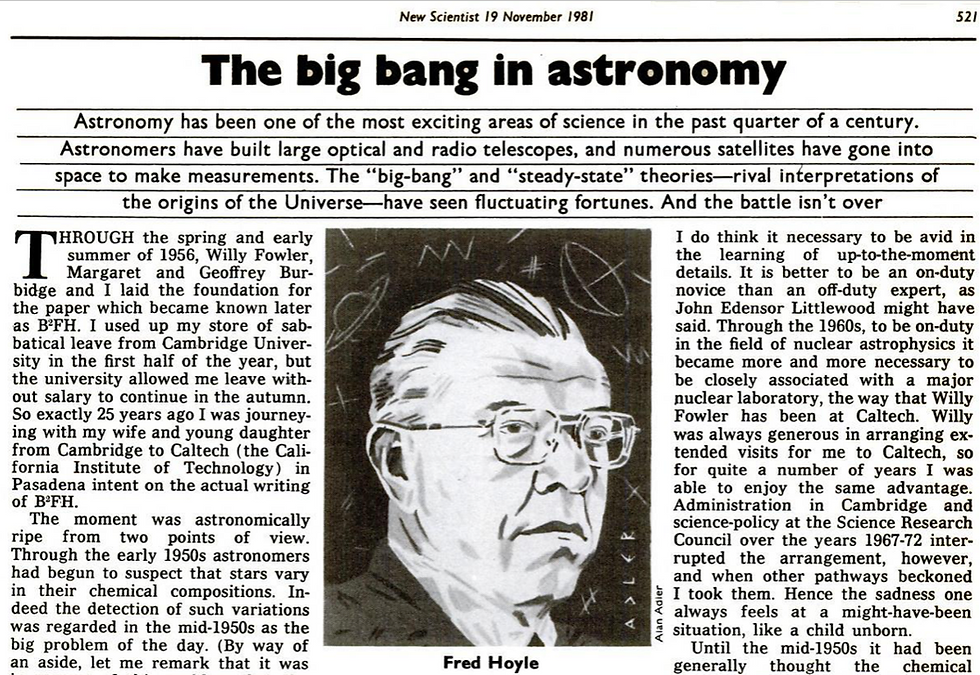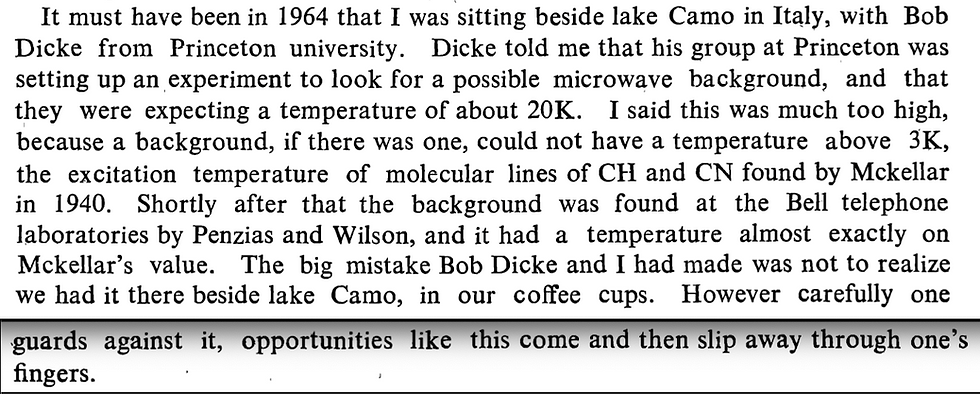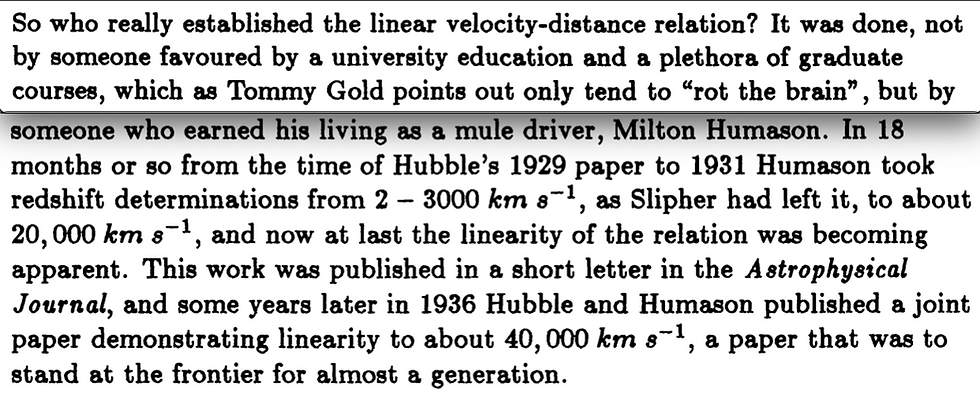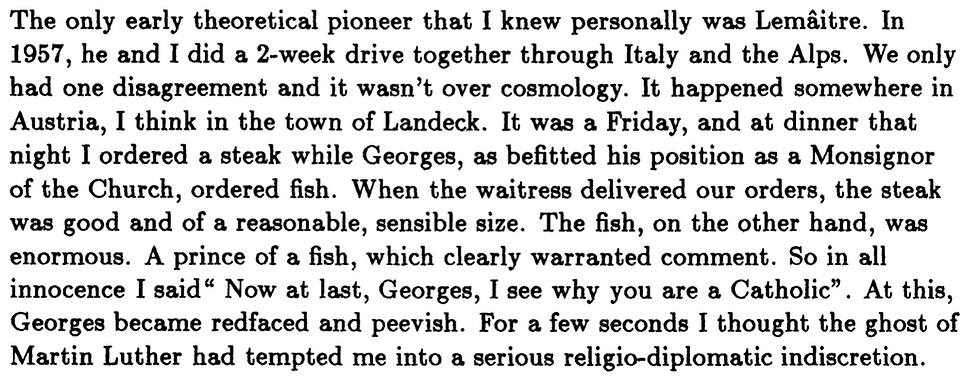Along with death and taxes, one other thing is certain: The history of science is always messier than the textbook presentation. A little Saturday morning detective work has taken me down a path I did not expect, so I thought I would put together some thoughts on what I found.
The discovery and study of the Cosmic Microwave Background (CMB) is considered a pillar of modern cosmology. Representing the left over radiation from the Big Bang, it shines on us from all directions at a balmy 2.725K.

I wrote about the importance of the CMB in my recent book, The Cosmic Revolutionary's Handbook, outlining the story of its prediction from theoretical work on the expanding early universe, to its serendipitous discovery.
The executive summary goes something like this. In the 1920's, Albert Einstein and Alexandr Friedmann were arguing over whether the mathematics of general relativity predict a static or evolving universe. By the 1930's, observations by Edwin Hubble were interpreted by Lemaitre as supporting an expanding universe. Running the clock backwards, Georges Lemaitre concluded that the universe had a beginning, some several billion years in the past, something he called the "primeval atom".
By the 1940's, George Gamow was wondering about the thermodynamics of this early universe, concluding it must have been exceedingly hot. With his student, Robert Alpher, he showed that the lightest elements could have been forged in the initial moments, publishing the famous Alpher-Bethe-Gamow paper in 1948 (Bethe's name was thrown on the paper as a joke, something that would be called "unprofessional" by the prim attitudes of academia today). The conclusion was that the leftover radiation from the Big Bang, immensely cooled, should still surround us in the universe today. What was uncertain was just what temperature we should expect this radiation to be.
The same conclusion was reached by Robert Dicke, Jim Peebles and Wilkinson in 1965, and they decided to design an experiment to search for the CMB. Little did they know, but 60 km way, Arno Penzias and Robert Wilson were having problems removing the noise from their observations using an antenna at Bell Labs. A fortunate series of events led to the conclusion that this noise was a detection of the CMB, Nobel prizes were awarded, and the rest, as they say, was history.

Except, this is not the whole story. As I write in the book, and as noted by others, evidence for the CMB was found in 1940. The star of this story is Andrew McKellar who was working at the Dominion Astrophysical Observatory on the lovely Vancouver Island in Canada.
Again, the executive summary is that McKellar was studying molecules between the stars, namely cyanogen (CN) and methyne (CH). By measuring how much light these molecules were absorbing, he was able to calculate their energetics, concluding they must be bathed in radiation a few degrees above absolute zero. There was no obvious source for this radiation, with Gerard Herzberg, a future Nobel prize winner saying that it "... has of course very restricted meaning".
McKellar published in an observatory journal, which was not read by many, and so the result was overlooked. His paper has sixty citations, the first occurring a quarter of a century after publication when its implications for the cosmic CMB were realised.

The lack of recognition of McKellar's work can be found in this summary from the book by Fred Hoyle, Geoffrey Burbidge and Jayant Narlikar from 2000. Whilst the book pushes their own (radical) cosmological ideas, the sentiment on McKellar hits the spot.

So, this is the established history.
But last night, some things began to unravel. I was looking over this article in New Scientist. These were clearly different days, with cognac adverts suggesting a refined readership of the magazine.

I have always been a fan of Fred Hoyle: when he was right, he was very right, but when he was wrong, such as steady state, panspermia and faked archaeopteryx, he was very wrong. But, as explained to me, he was not afraid to argue his point, no matter how right or wrong he was.
In the article, written twenty years before his death in 2001, he still defends steady state, but most of the field had moved on. But he has a way with writing that I really like, and he comes across as honest, even where he has to admit mistakes and failures. In this regards, I think his autobiography, "Home is where the wind blows", is much between than the several biographies written about him.
The article opens with the fact that he took unpaid leave to finish one of his most famous papers, concerning nuclear reaching in stars, known as B^2FH. This was in 1956, and he took time to catch up with Gamow to discuss cosmology. As Hoyle recounts:

Wait, what! Hoyle knew about McKellar's results and spoke with Gamow about them! These results that apparently (as the popular story goes) were forgotten. As the temperature was not what either wanted, they seemed to just move on from its significance.
When did Hoyle know about McKellar's work? Again, from the same article, it appears the answer is "as soon as they appeared in 1940!".

But the story is not over. A few years later, in 1988, Hoyle wrote a summary of his half-century career in astronomy. Again, very similar style, and I recommend a read!
Partway through the article, Hoyle recounts chatting with another astronomer about McKellar's work.

This time it's Robert Dicke, leader of the group building an instrument to search for the CMB! Again, as McKellar's result was not the temperature expected, it seems to have been ignored. But as Hoyle laments, if they had realised there and then, they would have understood the significance of McKellar's result.
How different would history have been if Gamow had known of McKellar's results when writing his 1948 paper? Unfortunately, the eventual realisation of what the temperature of these interstellar lines was telling us came too late for McKellar, who died in 1960 at the age of 50. But clearly his results were not unheard of, or lost in an unread journal. They were simply not appreciated for what they were.
Let's round up with a little more read, an article called Final Remarks, published by Hoyle in 1993. It contains a couple of anecdotes that I like, because it puts some personality skin and bones of the skeletons of people you find in most textbooks. The first is someone who is presented as a minor player on the cosmology stage, Milton Humason.


The other story relates to him taking a two-week drive with George Lemaitre through the Alps because, well, because, that's what you could do as an academic back in the 1950s!


I am not a historian of science, and don't know how much of this is reality as opposed to Hoyle's floundering memory. But it definitely makes a refreshing read....
Add some vintage vibes to your look with a Jacket with Fringe Womens. It blends classic western fashion with modern appeal, making it a standout piece. Perfect for festivals, casual outings, or adding flair to any outfit. Find your perfect style at Biker Jacket!
The Beth Dutton Blue Coat is an unforgettable style statement. Designed for fashion lovers who admire Beth’s bold personality. Stay cozy while looking effortlessly chic. Available now at Western Apparel.